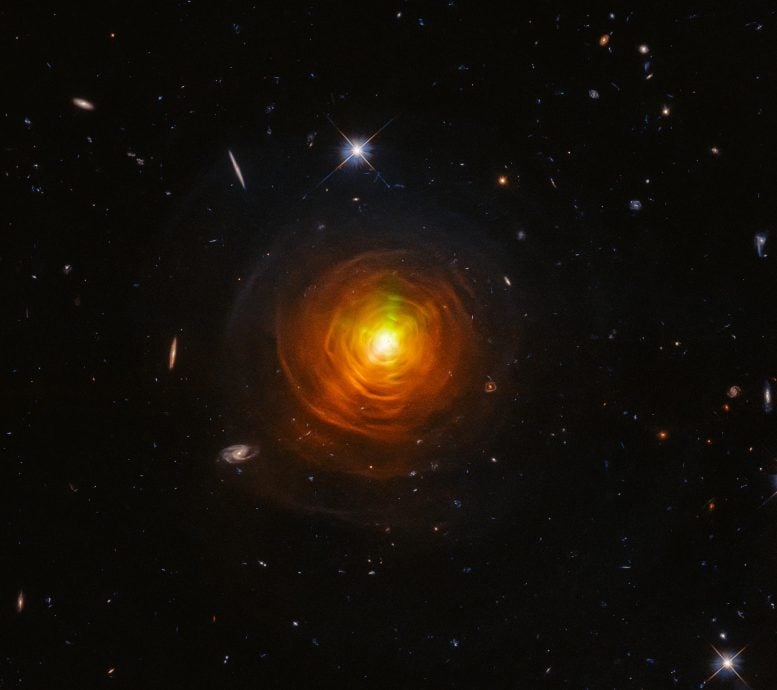A real death star

Just in time for Halloween, the red giant star CW Leonis offers us a view of orange-red “cobwebs” that are dusty clouds of sooty carbon engulfing the dying star. Credit: ESA/Hubble, NASA, and Toshiya Ueta (University of Denver), Hyosun Kim (KASI)
Creepy Look At A Star Weaving A Dust Web
The drama of death among stars can look pretty eerie at times. This photo of the aging red giant star CW Leonis seems like something out of a Halloween tale. The star looks like it’s entrapped inside wispy orange spider webs that wrap around the star. Beams of light shine through the dust, like sunbeams on a partly cloudy day.
This is a time-lapse set of images of the aging red giant star CW Leonis, taken on three dates: 2001, 2011, and 2016. The star is embedded inside gossamer cobwebs of dust encircling the star. These are really shells of carbon dust blown off the star. As they expand into space they change shape, as seen between the Hubble Space Telescope exposures. Brilliant searchlight beams from the star’s surface poke through the dust. These beams change orientation through the different dates the Hubble photographs were taken. Credit: Animation: ESA/Hubble, NASA, STScI, Acknowledgment: Toshiya Ueta (University of Denver), Hyosun Kim (KASI), M. Zamani
Hubble Celebrates Halloween with a Glowering, Dying Star
A hypnotizing vortex? A peek into a witch’s cauldron? A giant space-spider web?
In reality, it’s a look at the red giant star CW Leonis as photographed by NASA’s Hubble Space Telescope – just in time for celebrating Halloween with creepy celestial sights.
The orange-red “cobwebs” are dusty clouds of sooty carbon engulfing the dying star. They were created from the outer layers of CW Leonis being thrown out into the inky black void. The carbon, cooked up through nuclear fusion in the star’s interior, gives it a carbon-rich atmosphere. Blasting the carbon back into space provides raw material for the formation of future stars and planets. All known life on Earth is built around the carbon atom. Complex biological molecules consist of carbon atoms bonded with other common elements in the universe.
At a distance of 400 light-years from Earth, CW Leonis is the closest carbon star. This gives astronomers the chance to understand the interplay between the star and its surrounding, turbulent envelope. The complex inner structure of shells and arcs may be shaped by the star’s magnetic field. Detailed Hubble observations of CW Leonis taken over the last two decades also show the expansion of threads of ejected material around the star.
The bright beams of light radiating outwards from CW Leonis are one of the star’s most intriguing features. They’ve changed in brightness within a 15-year period — an incredibly short timespan in astronomical terms. Astronomers speculate that gaps in the dust shrouding CW Leonis may allow beams of starlight to pierce through and illuminate dust, like searchlight beacons through a cloudy sky. However, the exact cause of the dramatic changes in their brightness is as yet unexplained.
A star shines when the outward pressure from the fusion furnace at the core balances against the crush of gravity. When the star runs out of hydrogen fuel, the persistent pull of gravity causes the star to start collapsing. As the core shrinks, the shell of plasma surrounding the core becomes hot enough to begin fusing hydrogen, giving the star a second lease on life. It generates enough heat to dramatically expand the star’s outer layers and swell up into a bloated red giant.
NASA’s Hubble Space Telescope has spotted many bone-chilling objects in the universe. CW Leonis is just the most recent one. Credit: NASA’s Goddard Space Flight Center; Lead Producer: Paul Morris
CW Leonis has an orange-reddish color due to its relatively low surface temperature of 2,300 degrees Fahrenheit. The green-tinted beams of light emanating from the star, however, glow at invisible mid-infrared wavelengths. In the absence of natural color, green has been added to the infrared image for better analysis through color-contrast.
The Hubble Space Telescope is a project of international cooperation between NASA and ESA (European Space Agency). NASA’s Goddard Space Flight Center in Greenbelt, Maryland, manages the telescope. The Space Telescope Science Institute (STScI) in Baltimore, Maryland, conducts Hubble science operations. STScI is operated for NASA by the Association of Universities for Research in Astronomy, in Washington, D.C.